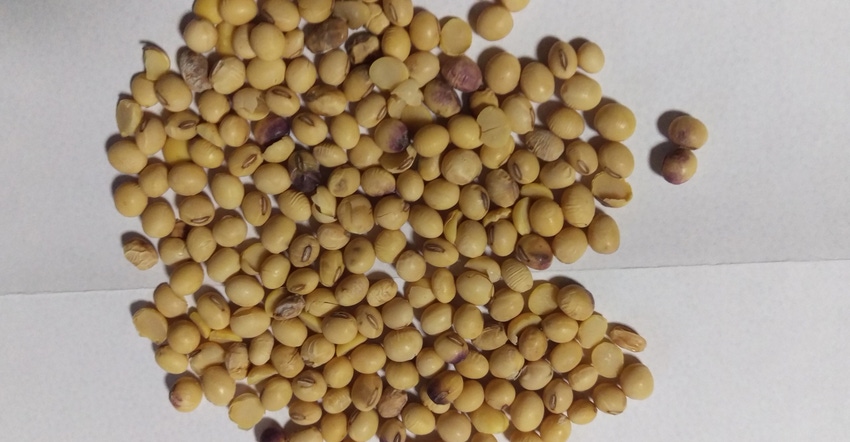November 1, 2018

By Aaron Berger and Mary Drewnoski
The wet conditions that delayed harvest have resulted in some loads of soybeans being rejected or sold at a large discount. However, rejected beans that are damaged or discolored can still be used as a protein source for cattle.
Soybeans can be a good protein source for cows and can be used in developing heifers, as well as growing and finishing rations.
Soybeans are typically about 40% crude protein and 20% fat. Due to the high fat content, damaged soybeans can become rancid; however, in cold weather this is less of an issue.
It is typically recommended to limit the amount of whole soybean in the diet to less than 10% to 20% on a dry matter basis, because too high of fat content can negatively affect the bacteria in the rumen. The protein in soybeans is highly ruminally degradable and therefore may not result in similar gains for growing cattle compared to distillers grain when used in forage-based rations.
It's also important to note that urea should not be used in rations in which raw soybeans are being used. Raw soybeans contain urease that can rapidly turn urea into ammonia and cause ammonia toxicity.
Testing for feed value
When buying damaged or discolored soybeans, it is important to have a feed analysis conducted on the soybeans to get an accurate assessment of their feed value. Deterioration in quality can occur due to weathering.
In evaluating if soybeans are price competitive to other protein sources, it's worth comparing them on a dry matter basis to other common feeds frequently used as a protein source.
The example in the table compares whole raw soybeans to alfalfa hay and dried distillers grain on a price per unit of protein. In this example, raw whole soybeans at 40% protein would need to be at $6.25 per bushel (or $208 per ton) or less to have a price per pound of crude protein that would be competitive with $160 per ton dried distillers grain.

The bottom-line number producers need to know is the cost per pound of nutrient either protein or energy — consumed by the cattle after all expenses and waste loss occur to accurately compare different feed options.
The Feed Cost Cow-Q-Lator spreadsheet and the NU Beef cowQlate app are two tools that let producers compare feed costs. They include delivery and storage expenses, as well as feeding cost and waste loss.
Grazing mature soybeans
Some farmers have considered not harvesting soybean fields that are too wet or that had excessive bean drop. These fields can be grazed. But understand that the plant itself has very little nutritional value (low in protein and energy). A forage source, such as corn residue or hay, must be provided.
Cattle may select full bean pods and can scour if they consume too much. One way to avoid this is to provide limited access to soybeans. Providing palatable hay or another feed may also reduce the likelihood of cattle overeating soybeans. Do not provide access to blocks, tubs or supplements that contain urea when allowing access to raw soybeans.
Damaged or discolored soybeans can be a good source of protein for cattle. Effectively comparing them to other readily available sources of protein can help identify what is a "fair" value for the soybeans as cattle feed.
Berger is a beef educator and Drewnoski is a beef systems specialist with Nebraska Extension. This report comes from UNL CropWatch.
You May Also Like




